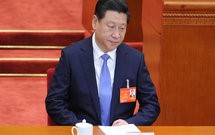 The Ukrainian political crisis, like the earlier crises in Egypt, Libya and Syria, is proving to be a nightmare for China, despite Beijing’s maintenance of a calm stance on the surface.
The Ukrainian political crisis, like the earlier crises in Egypt, Libya and Syria, is proving to be a nightmare for China, despite Beijing’s maintenance of a calm stance on the surface.
The referendum in Crimea is potentially applicable to Taiwan and Tibet. While the attempted 2004 and 2008 plans for referenda in Taiwan failed as it could not muster the required 50 per cent voter turnout, Beijing was palpably upset over the move. China is also wary of the Dalai Lama’s November 2007 statement that suggested a referendum for a decision over the future set up of the Tibetan leadership.
Given the impact of such a position on its minimalist foreign policy goals (such as the referendum issue over Taiwan and Tibet) and its maximalist goals (such as the rise of China, trade, conventional weapons import, nuclear agreement, etc), China is attempting a walk on the razor’s edge Hence, Beijing abstained from the UN Security Council draft resolution of March 16, 2014, proposed by the western countries and vetoed by Moscow, while calling for respecting “sovereignty and territorial integrity.”
The Ukrainian crisis also upsets the Chinese applecart – which it had assiduously built with Kiev since 1992. China and Ukraine have cobbled up a “strategic partnership” since 2011, and have mutually beneficial relations in trade, investments, conventional weapons transfer, and even a nuclear security agreement since December 2013. The $10 billion Beijing-Kiev bilateral trade is largely in favour of the former (with $7 billion in exports). Furthermore, apart from the construction of Kiev airport light rail and a power station, China plans to provide an estimated $8 to 10 billion in aid to the (compared to the $15 billion bail-out promised by the EU) in addition to developing over 7 million acres of land in eastern Ukraine.
In the light of the Western arms embargo on China following the Tiananmen Square incident in 1989, Ukrainian military exports to China proved crucial. These include turbofan engines, tankers, amphibious landing craft, gas turbines, diesel engines, self-propelled guns and even an aircraft carrier (Varyag, renamed Liaoning following refurbishment). These could be in jeopardy after the ouster of President Viktor Yanukovych, who visited China several times. During Yanukovych’s December 2013 visit, both sides approved a “Strategic Partnership Development Plan” for a four-year period from 2014-2018. Significantly, both signed an agreement according to which China will “provide Ukraine nuclear security guarantee when Ukraine encounters an invasion involving nuclear weapons or Ukraine is under threat of a nuclear invasion.”
China is wary of an impact of the “coloured revolutions” on its domestic political situation, as well as in Xinjiang and Tibet. It had expressed concerns over the spread of Georgia’s “Rose Revolution” in 2003, Ukraine's “Orange Revolution” in 2004-2005 and Kyrgyzstan's “Tulip Revolution” in 2005. China and Russia countered the West-sponsored UN human rights criticism of the “saffron revolution” in Myanmar in 2007.
Working with Russia proved to be beneficial to China in military technology transfers, trade, coordination at the UN, space in Central Asia (via the Shanghai Cooperation Organisation) and in its “pivot” to the West through the silk route to Europe. China – a major beneficiary of the West in terms of trade and technology – is also attempting to partner with the NATO which has made a presence on its western border with Afghanistan post the 9/11 attacks.
Since 2002, China had been engaging the NATO on counter-terrorism, piracy, proliferation of weapons of mass destruction and crisis management. This indicates that in the backdrop of the crisis in Ukraine, China is attempting a balancing act between Russia and the US/EU, even as expands its influence.
This balancing act means that China does not want to alienate Russia with whom it signed a “strategic partnership” in 2001 and interacts extensively on the international and regional order issues at the UN and in the multilateral institutions like the Shanghai Cooperation Organisation (SCO), BRICS, etc. China needs Russia for military technology as well as to counter the US “rebalancing in the Asia-Pacific.” Russia’s “pivot” towards Ukraine could also provide China with strategic opportunities in the Asia-Pacific, Africa and South America.
This not the first time China is performing the balancing act between Russia and the West. For instance, in the backdrop of Russia’s military response towards Georgia over the Abkhazia and South Ossetia issues, at the August 2008 SCO Dushanbe Summit, it decried the “use of armed force to resolve problems” and called for “respect of the basic tenets of international law.” It also stated that “not long ago, the members of this organization expressed deep concern about tensions generated in the situation surrounding South Ossetia, and called upon each relevant party to resolve peacefully current problems through dialogue.”
This indicates that without being explicit in its criticism of Russia, China has been conducting its foreign policy with caution and pragmatism, while also protecting its domestic interests.
By Special Arrangement with Institute of Peace and Conflict Studies (http://www.ipcs.org)